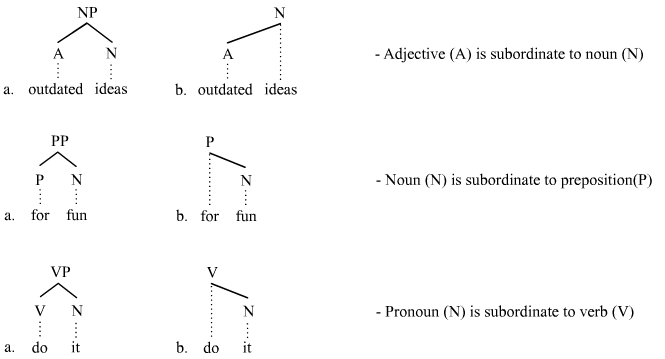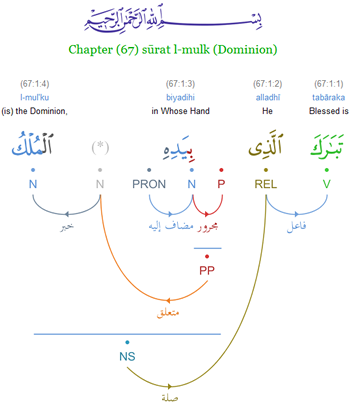|
Subordination (linguistics)
In linguistics, subordination (abbreviated variously , , or ) is a principle of the hierarchical organization of linguistic units. While the principle is applicable in semantics, morphology, and phonology, most work in linguistics employs the term "subordination" in the context of syntax, and that is the context in which it is considered here. The syntactic units of sentences are often either subordinate or coordinate to each other. Hence an understanding of subordination is promoted by an understanding of coordination, and vice versa. Subordinate clauses Subordination as a concept of syntactic organization is associated closely with the distinction between ''coordinate'' and ''subordinate'' clauses. One clause is subordinate to another if it depends on it. The dependent clause is called a ''subordinate clause'' and the independent clause is called the ''main clause'' (= matrix clause). Subordinate clauses are usually introduced by subordinators (= subordinate conjunctions) such ... [...More Info...] [...Related Items...] OR: [Wikipedia] [Google] [Baidu] |
Linguistics
Linguistics is the scientific study of language. The areas of linguistic analysis are syntax (rules governing the structure of sentences), semantics (meaning), Morphology (linguistics), morphology (structure of words), phonetics (speech sounds and equivalent gestures in sign languages), phonology (the abstract sound system of a particular language, and analogous systems of sign languages), and pragmatics (how the context of use contributes to meaning). Subdisciplines such as biolinguistics (the study of the biological variables and evolution of language) and psycholinguistics (the study of psychological factors in human language) bridge many of these divisions. Linguistics encompasses Outline of linguistics, many branches and subfields that span both theoretical and practical applications. Theoretical linguistics is concerned with understanding the universal grammar, universal and Philosophy of language#Nature of language, fundamental nature of language and developing a general ... [...More Info...] [...Related Items...] OR: [Wikipedia] [Google] [Baidu] |
Dependency Grammar
Dependency grammar (DG) is a class of modern Grammar, grammatical theories that are all based on the dependency relation (as opposed to the ''constituency relation'' of Phrase structure grammar, phrase structure) and that can be traced back primarily to the work of Lucien Tesnière. Dependency is the notion that linguistic units, e.g. words, are connected to each other by directed links. The (finite) verb is taken to be the structural center of clause structure. All other syntactic units (words) are either directly or indirectly connected to the verb in terms of the directed links, which are called ''dependencies''. Dependency grammar differs from phrase structure grammar in that while it can identify phrases it tends to overlook phrasal nodes. A dependency structure is determined by the relation between a word (a Head (linguistics), head) and its dependents. Dependency structures are flatter than phrase structures in part because they lack a finite verb, finite verb phrase constit ... [...More Info...] [...Related Items...] OR: [Wikipedia] [Google] [Baidu] |
Generative Syntax
Generative grammar is a research tradition in linguistics that aims to explain the cognitive basis of language by formulating and testing explicit models of humans' subconscious grammatical knowledge. Generative linguists, or generativists (), tend to share certain working assumptions such as the competence–performance distinction and the notion that some domain-specific aspects of grammar are partly innate in humans. These assumptions are rejected in non-generative approaches such as usage-based models of language. Generative linguistics includes work in core areas such as syntax, semantics, phonology, psycholinguistics, and language acquisition, with additional extensions to topics including biolinguistics and music cognition. Generative grammar began in the late 1950s with the work of Noam Chomsky, having roots in earlier approaches such as structural linguistics. The earliest version of Chomsky's model was called Transformational grammar, with subsequent iterati ... [...More Info...] [...Related Items...] OR: [Wikipedia] [Google] [Baidu] |
Natural Language And Linguistic Theory
''Natural Language & Linguistic Theory'' is a quarterly peer-reviewed academic journal covering theoretical and generative linguistics. It was established in 1983 and originally published by Kluwer Academic Publishers. Since 2004 the journal is published by Springer Science+Business Media. Since 2024, the editor-in-chief has been Daniel Harbour (QMUL). The journal carries a "Topic-Comment" column (initiated by Geoffrey K. Pullum), in which a contributor presents a personal, sometimes controversial, opinion on some aspect of the field. Abstracting and indexing The journal is abstracted and indexed in: According to the ''Journal Citation Reports'', the journal has a 2015 impact factor The impact factor (IF) or journal impact factor (JIF) of an academic journal is a type of journal ranking. Journals with higher impact factor values are considered more prestigious or important within their field. The Impact Factor of a journa ... of 0.845. References External links * Ling ... [...More Info...] [...Related Items...] OR: [Wikipedia] [Google] [Baidu] |
Studia Linguistica
''Studia Linguistica: A Journal of General Linguistics'' is a peer-reviewed academic journal of general linguistics established in 1947 and currently published by Wiley-Blackwell. Its current editors-in-chief are Christer Platzack (Lund University Lund University () is a Public university, public research university in Sweden and one of Northern Europe's oldest universities. The university is located in the city of Lund in the Swedish province of Scania. The university was officially foun ...) and Arthur Holmer. Linguistics journals Wiley-Blackwell academic journals Triannual journals English-language journals {{ling-journal-stub ... [...More Info...] [...Related Items...] OR: [Wikipedia] [Google] [Baidu] |
Journal Of Linguistics
The ''Journal of Linguistics'' is a triannual peer-reviewed academic journal covering all branches of theoretical linguistics and the official publication of the Linguistics Association of Great Britain. It is published by Cambridge University Press and is edited by Kersti Börjars, Helen de Hoop, Adam Ledgeway and Marc van Oostendorp. History The journal was established in 1965 and Sir John Lyons was its first editor (1965-1969). From 1969 until 1979, Frank R. Palmer was the editor-in-chief. Other past editors include Erik Fudge (University of Hull), Nigel Vincent ( The University of Manchester), Nigel Fabb ( University of Strathclyde), Caroline Heycock (University of Edinburgh), S.J. Hannahs (Newcastle University), and Robert D. Borsley (University of Essex). Current editors are Kersti Börjars (University of Oxford), Helen de Hoop (Radboud University Nijmegen), Adam Ledgeway (University of Cambridge) and Marc van Oostendorp (Radboud University Nijmegen Radboud ... [...More Info...] [...Related Items...] OR: [Wikipedia] [Google] [Baidu] |
Subordination Trees 2
{{disambig ...
Subordination may refer to *Subordination in a hierarchy (in military, society, etc.) ** Insubordination, disobedience *Subordination (linguistics) *Subordination (finance) *Subordination agreement, a legal document used to deprecate the claim of one party in favor of another * Subordination (horse), a Thoroughbred racehorse In mathematics * Littlewood subordination theorem * Subordinate partition of unity in paracompact space In mathematics, a paracompact space is a topological space in which every open cover has an open refinement that is locally finite. These spaces were introduced by . Every compact space is paracompact. Every paracompact Hausdorff space is normal ... [...More Info...] [...Related Items...] OR: [Wikipedia] [Google] [Baidu] |
Transformational Grammar
In linguistics, transformational grammar (TG) or transformational-generative grammar (TGG) was the earliest model of grammar proposed within the research tradition of generative grammar. Like current generative theories, it treated grammar as a system of formal rules that generate all and only grammatical sentences of a given language. What was distinctive about transformational grammar was that it posited transformation rules that mapped a sentence's deep structure to its pronounced form. For example, in many variants of transformational grammar, the English active voice sentence "Emma saw Daisy" and its passive counterpart "Daisy was seen by Emma" share a common deep structure generated by phrase structure rules, differing only in that the latter's structure is modified by a passivization transformation rule. Basic mechanisms Transformational grammar was a species of generative grammar and shared many of its goals and postulations, including the notion of linguistics as a ... [...More Info...] [...Related Items...] OR: [Wikipedia] [Google] [Baidu] |
Phrase Structure Grammar
The term phrase structure grammar was originally introduced by Noam Chomsky as the term for grammar studied previously by Emil Post and Axel Thue ( Post canonical systems). Some authors, however, reserve the term for more restricted grammars in the Chomsky hierarchy: context-sensitive grammars or context-free grammars. In a broader sense, phrase structure grammars are also known as ''constituency grammars''. The defining character of phrase structure grammars is thus their adherence to the constituency relation, as opposed to the dependency relation of dependency grammars. History In 1956, Chomsky wrote, "A phrase-structure grammar is defined by a finite vocabulary (alphabet) Vp, and a finite set Σ of initial strings in Vp, and a finite set F of rules of the form: X → Y, where X and Y are strings in Vp." Constituency relation In linguistics, phrase structure grammars are all those grammars that are based on the constituency relation, as opposed to the dependency relation ... [...More Info...] [...Related Items...] OR: [Wikipedia] [Google] [Baidu] |
List Of Glossing Abbreviations
This article lists common abbreviations for grammatical terms that are used in linguistic interlinear glossing of oral languages in English. The list provides conventional glosses as established by standard inventories of glossing abbreviations such as the Leipzig Glossing Rules, Leipzig Glossing rules, the most widely known standard. Synonymous glosses are listed as alternatives for reference purposes. In a few cases, long and short standard forms are listed, intended for texts where that gloss is rare or uncommon. Conventions * Grammatical abbreviations are generally written in full or small caps to visually distinguish them from the translations of lexical words. For instance, capital or small-cap (frequently abbreviated to ) glosses a grammatical past-tense morpheme, while lower-case 'past' would be a literal translation of a word with that meaning. Similarly, (small) cap might be a locative suffix used in nominal inflections, prototypically indicating direction downward b ... [...More Info...] [...Related Items...] OR: [Wikipedia] [Google] [Baidu] |
Head
A head is the part of an organism which usually includes the ears, brain, forehead, cheeks, chin, eyes, nose, and mouth, each of which aid in various sensory functions such as sight, hearing, smell, and taste. Some very simple animals may not have a head, but many bilaterally symmetric forms do, regardless of size. Heads develop in animals by an evolutionary trend known as cephalization. In bilaterally symmetrical animals, nervous tissue concentrate at the anterior region, forming structures responsible for information processing. Through biological evolution, sense organs and feeding structures also concentrate into the anterior region; these collectively form the head. Human head The human head is an anatomical unit that consists of the skull, hyoid bone and cervical vertebrae. The skull consists of the brain case which encloses the cranial cavity, and the facial skeleton, which includes the mandible. There are eight bones in the brain case ... [...More Info...] [...Related Items...] OR: [Wikipedia] [Google] [Baidu] |




